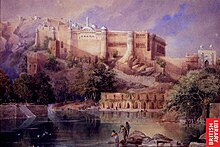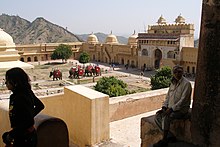Amber Fort
With its large ramparts and series of gates and cobbled paths, the fort overlooks Maota Lake,[4][5][6][7] which is the main source of water for the Amer Palace.Later a Kachhwaha prince, Dulha Rai, destroyed the sovereignty of Meenas and also defeated Bargurjars of Deoli and took Dhundhar fully under Kachwaha rule.Improvements and additions were made by successive rulers over the next 150 years, until the Kachwahas shifted their capital to Jaipur during the time of Sawai Jai Singh II, in 1727.This was the place where armies would hold victory parades with their war bounty on their return from battles, which were also witnessed by the Royal family's womenfolk through the latticed windows.Above this gate is the Suhag Mandir where ladies of the royal family used to watch functions held in the Diwan-i-Aam through latticed marble windows called "jâlîs".The legend attributed to the installation of this deity is that Maharaja Man Singh sought blessings from Kali for victory in the battle against the Raja of Jessore in Bengal.The Raja, after he won the battle of Bengal in 1604, retrieved the idol from the sea and installed it in the temple and called it Sila Devi as it was carved out of one single stone slab.This stone was then used to carve the image of Durga Mahishasuramardini, who had slain the asura king Mahishasura and installed it in the fort's temple as Sila Devi.The practice was to sacrifice a buffalo and also goats on the eighth day of the festival in front of the temple, which would be done in the presence of the royal family, watched by a large gathering of devotees.The building to the left of the entrance gate is called the Jai Mandir, which is exquisitely embellished with glass inlaid panels and multi-mirrored ceilings.A particular attraction here is the "magic flower" carved marble panel at the base of one of the pillars around the mirror palace depicting two hovering butterflies; the flower has seven unique designs including a fishtail, lotus, hooded cobra, elephant trunk, lion's tail, cob of corn, and scorpion, each one of which is visible by a special way of partially hiding the panel with the hands.Built during the reign of Sawai Jai Singh (1699–1743 AD), it is covered with frescoes; its alignment is zigzag, probably made so from security considerations to attack intruders.In the central courtyard of the palace is the pillared baradari or pavilion; frescoes and colored tiles decorate the rooms on the ground and upper floors.This town is spread over an area of 4 square kilometres (1.5 sq mi) and has eighteen temples, three Jain mandirs, and three mosques.However, these renovation works have been a subject of intense debate and criticism with respect to their suitability to maintain and retain the historicity and architectural features of the ancient structures.[33] A film unit shooting a film at the Amer Fort damaged a 500-year-old canopy, demolished the old limestone roof of Chand Mahal, drilled holes to fix sets and spread large quantities of sand in Jaleb Chowk in utter disregard and violation of the Rajasthan Monuments, Archaeological Sites and Antique Act (1961).[34] The Jaipur Bench of the Rajasthan High Court intervened and stopped the film shooting with the observation that "unfortunately, not only the public but especially the concerned (sic) authorities have become blind, deaf and dumb by the glitter of money.[36] In 2017, A New York-based tour operator announced it would use Jeeps instead of elephants for the trip to Amber Fort, saying "It’s not worth endorsing … some really significant mistreatment of animals."[37] An engraving of a painting of the fort by W. Purser, under the title Shuhur, Jeypore, was published in Fisher's Drawing Room Scrap Book, 1834, with a poetical illustration by Letitia Elizabeth Landon.







RajasthanPalaceGovernment of RajasthanMan Singh ISandstonemarbleUNESCO World Heritage SitesessionSouth AsiaJaipurMaota LakeRajput architectureMughal architectureRajputMaharajasShila DeviBengalJessoreBangladeshJaigarh FortAravalliWorld Heritage CommitteePhnom PenhCambodiaHill Forts of RajasthanWilliam SimpsonSusawatKachhwahaJai Singh ISawai Jai Singh IIDhundarArabicGaneshaMahabharataKrishnaMahishasuramardiniMahishasuraRamgarhNavaratribuffaloMughal GardensalabastersandalwoodZenanabaradariChittor FortGagron FortJaisalmer FortKumbhalgarhRanthambore FortLetitia Elizabeth LandonWikisourceD. Fairchild RugglesThe HinduSarkar, JadunathThe Times of IndiaAchalgarhAlwar fortAmer FortBhainsrorgarhBijai GarhHindaun FortJalore FortJunagarh FortKankwadiKhandar FortKuchaman CityLohagarh FortMehrangarhNahargarh FortSiwanaTaragarh FortTiman GarhForts in IndiaAhom dynastyTalatal GharKareng GharRang GharGarchuk Lachit GarhBahmani SultanateGulbargaBritish RajAnchuthenguSt. GeorgeWilliamBombayMazagonSion HillockTellicherrySt. DavidDeccan sultanatesAhmednagarDaulatabadGawilghurGolcondaJalna FortNarnalaPanhalaDelhi SultanateAligarhBandhavgarhHathrasQila MubarakTughlaqabadSalimgarhEastern Ganga dynastyBarabatiRaibaniaFaruqi dynastyAsirgarhLalingThalnerGujarat SultanateBhadraBawana FortLohagarhNahar Singh MahalKakatiya dynastyWarangalKingdom of MysoreDevanahalliPalakkadSankagiriMalwa SultanateMandsaurMandavgadh